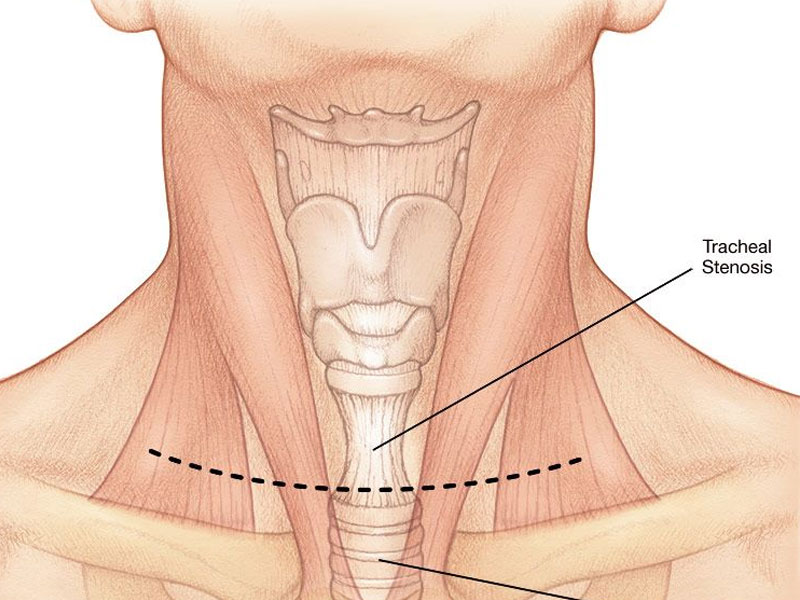
Tracheal Stenosis
Tracheal stenosis is a narrowing or constriction of the trachea. Most cases of tracheal stenosis develop when a persons trachea is injured after prolonged intubation - when a breathing tube is inserted into the trachea to help maintain breathing during a medical procedure - or from a tracheostomy (surgical opening of the trachea).Tracheal stenosis can also develop from a number of other causes, including external injury to the throat; when a benign or malignant tumor presses on the windpipe; certain autoimmune disorders (polychondritis, sarcoidosis, papillomatosis, amyloidosis and Wegeners granulomatosis); and infections (bacterial and fungal infections as well as tuberculosis). It can also develop as a side effect of radiation therapy when administered to treat a tumor in the head or neck.
Symptoms of Tracheal Stenosis
Shortness of breath, coughing, wheezing, difficult or labored breathing (dyspnea) difficult-to-treat asthma diagnosed in an adult, stridor (a high-pitched sound that can be heard as the breath is drawn in and is caused by a blockage in the throat or voice box) frequent inflammation of the lungs (pneumonitis) or recurrent respiratory infections fatigue and general feeling of discomfort (malaise)
cyanosis (bluish color in the skin or mucous membranes in the mouth or nose).
Diagnosis of Tracheal Stenosis
The diagnosis is by CT scan of the neck and chest and bronchoscopy.
Treatment
Tracheal surgery treats a multiplicity of ailments, illnesses and disorders that affect the role of the trachea (windpipe). This embraces airway blockages, tumorous and nontumorous growths and issues with the larynx (voice box). Tracheal surgery can reinstate breathing function and improve life’s quality for individuals with common or rare tracheal disorders. Your trachea, or windpipe, begins in the neck just beneath the voice box and continues downward behind the breastbone. It splits into two smaller pipes named bronchi that transport air to each lung. Your trachea is made of muscle, connective tissue, and rings of rigid cartilage. It also has a coating of humid mucus membranes. Your trachea inflates and contracts marginally as you respire. Tracheal surgery is major operation that has perils and prospective complications. You might have less invasive treatment choices.
Types of Tracheal Surgery
Laryngotracheal reconstruction reconstructs and broadens the windpipe using portions of cartilage from another region or from a donor.
Laryngotracheal resection and reanastomosis confiscates a segment of the windpipe and seams the two ends.
Tracheostomy makes a stoma (hole) in the front of the neck and via the trachea. A tube is introduced in the opening. The tube offers an air route for inhalation and a way to confiscate lung secretions and surplus mucus.
Why is tracheal surgery performed?
Your tracheal surgeon in Delhi might vouch for tracheal surgery to treat an ailment, disorder or complaint that affects the purpose of the trachea (windpipe). This is not a common operation. Your doctor will only contemplate tracheal surgery if less invasive treatments are fruitless. Your doctor might acclaim tracheal surgery to treat: Fistulas or uncharacteristic connections between the esophagus and windpipe Stenosis or tapering of the windpipe Subglottic stenosis or tapering of the region straight beneath the voice box Cancers including both tumorous and nontumorous growths

Dr Shashikiran N J
MBBS, MS, MCh
Lead Consultant Minimally Invasive Thoracic surgery
Apollo Hospitals Hyderabad
